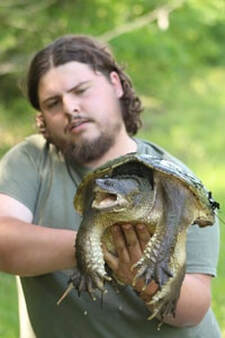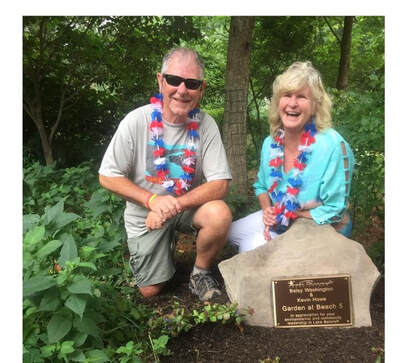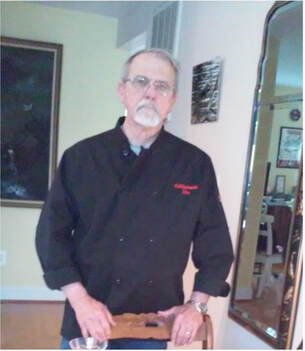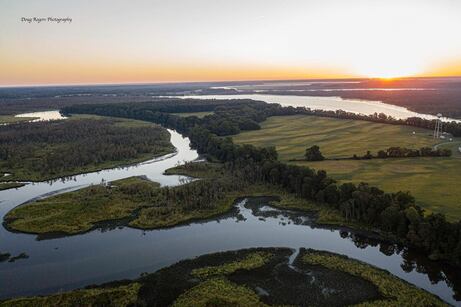 Ty Smith, VMN volunteer in the Central Piedmont Chapter, observing one of his herpetological finds.
Ty Smith, VMN volunteer in the Central Piedmont Chapter, observing one of his herpetological finds.
Central Piedmont Chapter Volunteer Ty Smith Contributes Unique Herp Observations
–Submitted by JoAnn Jones, VMN Central Piedmont Chapter
What’s the first thing you think about when you hear the term “road cruising”? For Ty Smith, of Central Piedmont VMN, “road-cruising” is a nighttime activity that often yields many sightings of herps! Ty’s passion for amphibians and reptiles keeps him cruising the Central Piedmont and beyond, always on the lookout for creatures with scutes, scales, and moist skins. He is often accompanied by Evan Spears, another member of the Central Piedmont Chapter.
In 2020, Ty took his road cruising to a new level as he began his own personal Herp BIG YEAR! This took place mostly in Virginia, although he did manage to get out of the state several times, when work and pandemic conditions allowed. Ty documented each sighting on iNaturalist, and by the end of the year, had amassed an unprecedented 123 herp species in Virginia, including a number of rarities! This gave him the distinction of being in the #1 spot of iNat’s Virginia leaderboard for herp species in 2020. Included in that number are all 28 native species of Virginia frogs and toads, as well as an invasive Cuban Tree Frog (found at the Lowe’s in Farmville). Ty recounted that his most challenging find was the Leatherback Turtle. He was able to ID and photograph the turtle while on a pelagic trip off the coast of Virginia Beach.
Ty is our resident herp expert in the field, and is always ready and willing to share his knowledge with our membership and the general public. He can be officially termed the Herpetology Good Will Ambassador!
Check out Ty’s observations online at:
https://www.inaturalist.org/people/tysmith
https://www.inaturalist.org/projects/ty-smith-s-herp-big-year-2020
 Kevin Howe and Betsy Washington, VMN Northern Neck Chapter volunteers.
Kevin Howe and Betsy Washington, VMN Northern Neck Chapter volunteers.
–Submitted by Camille Grabbe, VMN Northern Neck Chapter
For several years, the Northern Neck Master Naturalists have partnered with the Native Plant Society to offer a New Year’s Day hike for the general public through a local nature preserve, Hickory Hollow. The walks were led and narrated by members of these two groups. Of course, Covid protocols in 2020 forced a change to the plans. Options were discussed: perhaps having multiple walks, with folks registering for specified times, so group size could be limited; maybe someone could hike the trails with a drone, recording and narrating as he walked and sharing that via Zoom; or just giving up on the tradition for this past New Year’s Day. Betsy and Kevin, retired biologists and enthusiastic VMN volunteers, had an even better idea. The two of them walked the trails in Hickory Hollow in early January, taking photographs of interesting plants and animals along the way. They created a PowerPoint presentation, titled “Winter Flora and Fauna of Hickory Hollow,” which would be shared via Zoom. The local weekly newspaper published two articles about it, and Betsy and Kevin narrated their presentation at a general meeting for Virginia Master Naturalists to which the public was also invited. Over 40 people attended the Zoom event, equally split between VMN volunteers and the public, and the feedback from everyone was glowing. Hickory Hollow saw more traffic than normal in the weeks that followed, as everyone was eager to see for themselves, in person, the natural world that Betsy and Kevin had so enthusiastically shared through their outstanding photos and their lively interpretation. The presentation continues to inspire others, as both the local Audubon Society and the Northern Neck Master Naturalists have the recording posted on their websites.
 John Narney, VMN volunteer in the Northern Neck Chapter. Photo by Pam Narney.
John Narney, VMN volunteer in the Northern Neck Chapter. Photo by Pam Narney.
-Submitted by Camille Grabbe, VMN Northern Neck Chapter
John has been a member of the Northern Neck Master Naturalists since 2010. His wife had completed BTC the year before, and the chapter was in need of more trainees for the 2010 BTC, so she recruited John. This is, perhaps, the first indication of his volunteer attitude. John completed BTC and immediately immersed himself in the projects of the chapter. He became the Outreach Booth coordinator and served in that role for ten years, carting the materials and setting up at numerous places throughout the Northern Neck. He also began his tenure as newsletter editor at this time and continued in that role for at least 6 years. Like most naturalists, by 2011 he had discovered his real passion: bluebirds! He began coo
rdinating three trails in the northern area of our chapter. He recruited, trained, and scheduled volunteers, put together their binders and needed equipment, maintained the trails, built and cleaned the boxes, gave public presentations on bluebirds, and prepared the bluebird data for the annual report.
Our chapter, having been formed in 2007, was still in its “toddlerhood” with less than three dozen members when John joined. Often members needed to take on several roles in order to get everything done. John coordinated the first few “VMN Photo Contests” for the chapter–prior to the days of digital photography! He has been a trail monitor for the DGIF (now DWR) Virginia Bird and Wildlife Trail since that program began, trail monitor at the Voorhees Preserve (a Nature Conservancy property) for four or five years, and completed the MEWE (Meaningful Educational Watershed Experience) training, traveling across Virginia to attend the sessions.
By 2012, John had become a Board member. Since that time, he has served on the Board in numerous roles, including newsletter editor, projects chair (seven years), chapter email coordinator (nine years), membership chair (two years,) and VMN contact point (two years). In eleven years as a Master Naturalist, he has logged almost 1,000 volunteer hours and has held 36 terms in a leadership role in the chapter. Although “retiring” from the Board this year, John was gracious enough to stay on as the VMN contact in order to help with the chapter’s transition to the new volunteer system, “Better Impact.”
When there was a need, John was always one to step up and say “Okay, I will do that.” We are grateful to John for immersing himself in numerous chapter activities in order for it to develop into the vital and dynamic chapter that it is now. Those of us who are “newer” members may not always realize what it has taken in the past to be where we are today. John is noteworthy for his dedication, commitment, and service to the chapter and to the mission of the Virginia Master Naturalists.
 Aerial photo of The Nature Conservancy’s Cumberland Marsh Preserve, taken by Doug Rogers, VMN Rivanna Chapter.
Aerial photo of The Nature Conservancy’s Cumberland Marsh Preserve, taken by Doug Rogers, VMN Rivanna Chapter.
–Submitted by Karen Mulder, VMN Rivanna Chapter
During 2020, Citizen Science projects garnered the most volunteer hours, due to many education and stewardship projects being postponed. This highlight focuses on a specialized talent a volunteer used this year to bring data to several organizations. RMN Doug Rogers used his unique ability of being a certified drone pilot to participate in several projects, collecting data for the Rivanna Conservation Alliance (RCA), The Nature Conservancy (TNC), and other non-profit organizations. In addition, many Master Naturalists enjoyed his photos and videos through his posts on the RMN Facebook site.
Doug had 50 hours split between C-Rivanna Conservation Alliance Citizen Science and the
C-RMN Citizen Science Umbrella Project. For RCA, Doug was able to get elusive landowner permissions in order to photograph the confluence of several rivers. It was interesting to see in real time the different sediment load contributions as the rivers joined together. Also for RCA, Doug photographed a series of ponds at their Scheier Natural Area. This data was helpful in planning a pond restoration program.
For TNC Doug took shots of the marsh at the Cumberland Marsh Preserve – sunrise, low water and high water shots. TNC also requested photos of a new 1,50-acre parcel that had just been donated to TNC in Highland County. TNC needed several shots of different pieces of the property, and they specifically wanted shots of a stand of Red Spruce trees on a very distant and high (3,700′) ridge, which was not easily reached by vehicle, but Doug got it all done. Doug will do additional work with TNC as he has signed up for the training to do aerial mapping of TNC properties using their software. Part of the future work will involve documenting controlled burns. Doug also took photos for the Rockfish Gap Hawk Watch, a 501(c)3 Virginia non-profit, and a video for the Hanging Rock Hawk Watch, another 501(c)3 non-profit in Gap Mills, WV.
This unique skill brings another tool to citizen science data collection. Doug truly has the skill and passion for this work. Asked what motivates him, Doug stated “I love the natural world, its interconnected ecosystems and all of the wildlife that make a living out there – with a special fondness for birds. As a child, I lived on a subsistence farm in King George County, VA and learned to have a reverence for the air, the water and the land. Our very lives depended on it at a very personal level. Being a grandfather, I hope to leave some of that wonder of nature that I feel, to my grandchildren and all who come after me. I want to make a difference. And I love photography, especially when I can show the wonders of the natural world to others in ways that enhance their understanding and encourage them to help preserve natural places.
